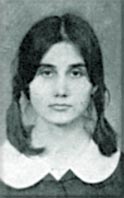Veliko Tarnovo Overview and Travel Guide
31.07.2012 § 2 Comments
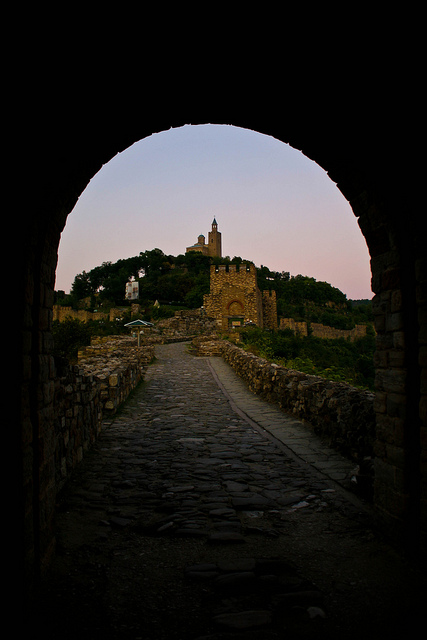
Overview
This is the catch-all post for anyone interested in visiting Veliko Tarnovo. Here I will link to all the individual articles of interest, as well as provide basic practical information about your visit.
In the foothills of the Balkan mountains, around the twists and turns of the Yantra river rise three hills: Tzarevetz, Sveta Gora and Trapezitza. Perched atop these hills and reflected in the river are the houses and castle walls of Veliko Tarnovo – the capital of the Second Bulgarian Empire and once the beating cultural heart of South-Eastern Europe.
« Read the rest of this entry »
Pinocchio (Intermediate Bulgarian Text)
30.07.2012 § Leave a comment
The following is a retelling of the story of Pinocchio by Carlo Collodi.
Имало едно време в Италия майстор дърводелец на име Джепето. Той си нямал деца и дълго търсел говорещо дърво, от което да си измайстори кукла за свой син. Най-сетне в един мразовит ден той открил вълшебното дърво и започнал да дяла от цепеницата човече.
И какво мислите се случило?
Издялал Джепето главата на човечето и като издълбал очите, то го погледнало насмешливо. Оформил устата, а тя, вместо да каже “Скъпи татко”, му се изплезила. Сглобил Джепето ръцете на куклата, а те го пернали по челото. Сглобил и краката – ритнали го. Ядосал се тогава дърводелецът:
– Това човече е голям немирник. За назидание ще го нарека на името на стария просяк от парка Пинокио! « Read the rest of this entry »
Transliteration of “Боженци”: Bonus Post
29.07.2012 § Leave a comment
 While I was writing about the village of Bozhentsi, I came face to face with a very common issue that occurs when converting between alphabets: transliteration. Not only do some Cyrillic letters lack direct equivalents, they are also differently transliterated in different Western languages. I’ll use the name of the village of Bozhentsi as an example.
While I was writing about the village of Bozhentsi, I came face to face with a very common issue that occurs when converting between alphabets: transliteration. Not only do some Cyrillic letters lack direct equivalents, they are also differently transliterated in different Western languages. I’ll use the name of the village of Bozhentsi as an example.
Bozhentsi: The End of The Road
29.07.2012 § 1 Comment
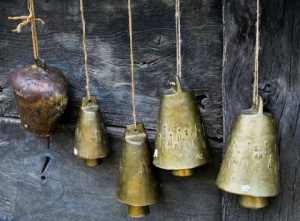 The tiny, barely marked turnoff takes us off the main road to Shipka pass and the drive winds past a few tiny villages, narrowing as it goes, twisting and turning to take us to the village of Bozhentsi. It’s where the road ends. To us, it marks the final point of our short pleasure drive and a chance to stretch our legs in search for dinner on a scorching Saturday afternoon. To the few survivors who fled Veliko Tarnovo after the Ottoman conquest, it meant the beginning of a new life in the safety of the nearby hills. « Read the rest of this entry »
The tiny, barely marked turnoff takes us off the main road to Shipka pass and the drive winds past a few tiny villages, narrowing as it goes, twisting and turning to take us to the village of Bozhentsi. It’s where the road ends. To us, it marks the final point of our short pleasure drive and a chance to stretch our legs in search for dinner on a scorching Saturday afternoon. To the few survivors who fled Veliko Tarnovo after the Ottoman conquest, it meant the beginning of a new life in the safety of the nearby hills. « Read the rest of this entry »
Samovodska Sweetness
28.07.2012 § 2 Comments
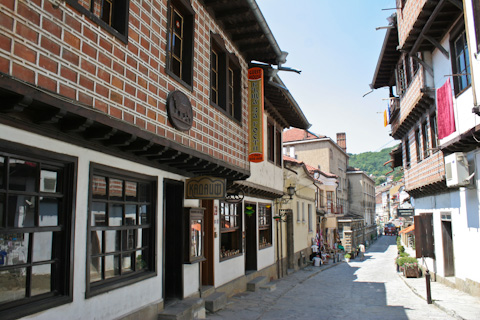 Veliko Tarnovo’s pedestrian shopping street, where authentic Revival-era artisans jostle with tourist trap souvenir shops, is called Самоводската чаршия (“Samovodskata charshia”). The word чаршия, borrowed from Turkish, means “shopping square/street” (if you’ve ever been to Istanbul, you may have heard of its enormous indoor market Kapalı çarşı), and Samovodska comes from the fact that this road used to lead, and be largely populated by produce sellers from, the nearby village of Samovodene.
Veliko Tarnovo’s pedestrian shopping street, where authentic Revival-era artisans jostle with tourist trap souvenir shops, is called Самоводската чаршия (“Samovodskata charshia”). The word чаршия, borrowed from Turkish, means “shopping square/street” (if you’ve ever been to Istanbul, you may have heard of its enormous indoor market Kapalı çarşı), and Samovodska comes from the fact that this road used to lead, and be largely populated by produce sellers from, the nearby village of Samovodene.
As you walk up and down this lovely, narrow, timeless avenue, try to spot the authentic Revival-era masters who have made it their home. Nowhere is this quest more pleasant or delicious than inside the shop of Neli Boncheva. « Read the rest of this entry »
Like an Eastern Block Leader
28.07.2012 § 1 Comment
 The five-star Arbanassi Palace hotel is perched on the crags above Veliko Tarnovo with phenomenal views of the city and the surrounding hills. What makes it unique among luxury hotels in the country is that it was designed and built as a residence for the People’s Republic of Bulgaria long-ruling head of state, Todor Zhivkov. « Read the rest of this entry »
The five-star Arbanassi Palace hotel is perched on the crags above Veliko Tarnovo with phenomenal views of the city and the surrounding hills. What makes it unique among luxury hotels in the country is that it was designed and built as a residence for the People’s Republic of Bulgaria long-ruling head of state, Todor Zhivkov. « Read the rest of this entry »
The Golden Treasure of Panagyurishte
27.07.2012 § 1 Comment

The Panagyurishte treasure, named after a tongue-twisting town in Bulgaria, is a masterpiece of Thracian worksmanship. It consists of a phiale, an amphora and seven rhytons, all made of solid 24-carat gold. The treasure weighs a total of 6.164 kg (13.5 pounds) and is arguably the single most valuable set of artifacts ever found on the territory of Bulgaria.
Care and Neglect
27.07.2012 § 2 Comments
On Veliko Tarnovo‘s main pedestrian shopping street, among the artisans and souvenir shops, stand two buildings which are not too different, really. They’re both heritage buildings, over 100 years old, both owned by private entities, and they exhibit the perfect duality of the conditions of private enterprise in Bulgaria. Yin and yang, order and chaos, careful preservation and haphazard decay. « Read the rest of this entry »
Horseback Riding in Veliko Tarnovo
27.07.2012 § 4 Comments
 There are many places in Bulgaria where you might be offered to ride a horse, often for lots of money, near the seaside, by somewhat unsavoury-looking characters. Those horses are also likely not very well treated, and spend most of their days being dragged around in the heat along the beaches of the Black Sea.
There are many places in Bulgaria where you might be offered to ride a horse, often for lots of money, near the seaside, by somewhat unsavoury-looking characters. Those horses are also likely not very well treated, and spend most of their days being dragged around in the heat along the beaches of the Black Sea.
However, there is at least one stable in the country that offers horseback riding as an experience, at reasonable rates, and couples it with a thorough introduction to the stable’s 50-some horses and a tour of their living environment.
Walking Tour of Revival-Era Plovdiv
26.07.2012 § 2 Comments

Plovdiv, along with being the site of numerous monuments from its Roman-era past as provincial capital, was also a thriving medieval fortress and an important regional city during the Ottoman rule in Bulgaria and the period of National Revival.
Three of Plovdiv’s six hills are home to an extremely well-preserved Revival-era old town. Housing the city’s art gallery, numerous museums and Revival-era homes preserved and opened to visitors, the Old Town is a must-see during a visit to Plovdiv. Many of the houses on the tour have courtyards walled in by high brick fences, and all feature smaller-area foundations and second and third floors that jut out into the street.
This walking tour will be described as a loop, with one easy entry point from Djumaya mosque square. Keep in mind that, although it’s not clear on the map, this walk involves a few hours of walking up and down hills on cobbled streets. Wear comfortable shoes! Also, unless otherwise stated, museum exhibits are bilingual and available in English. The tour starts in the middle of the main pedestrian street, at Djumaya square.
1. Djumaya Mosque (A)

Djumaya Mosque
The mosque predates the final conquest of Bulgaria, having been built by the Ottomans in the late 1300’s after the fall of Plovdiv. It is built in the older Islamic style, with nine domes resting on four huge internal pillars, which makes it very similar to the mosque in Cordoba. It is an imposing cultural monument and a universal landmark of the city. Any cabbie in Plovdiv can take you to “Djumayata”.
You’ll find the front entrance of the mosque on Saborna street, behind the rolling moat of the Ancient Stadium of Philippopolis.
2. Ascension of the Virgin Mary (“Sveta Bogorodica”) Church (B)

Sveta Bogorodica Church
Instead of taking Saborna, look for the passage behind the mosque, on Krivolak St. Walk past the mosque’s rear along Krivolak for a few blocks and you’ll see a V-shaped intersection. The left side is closed off with a car barrier, and the right is a steep set of stairs leading up to a tall pink tower – the bell tower of the city’s cathedral church – “Ascension of the Virgin Mary”. Built in 1844, it’s a prime example of the Revival period, signalling the start of Bulgaria’s struggle for church independence. It was here that the Plovdiv bishop Paisii read a holy liturgy in Bulgarian, declaring his separation from the Istanbul patriarchate and petitioning the sultan for an independent church. After a few years of struggle, the autocephalous Bulgarian church was re-established in 1870. You’re welcome to enter the church, as it is beautiful inside.
3. The Ancient Theatre (C)
The Roman-era Ancient theatre is on the Old Town hill, and it’s described in detail in my post on Roman architecture in Plovdiv. If you haven’t ventured out to see it on your Roman walk, you should head up the stairs past the church, then down Todor Samodumov street, then turn right on Tzar Ivailo.
4. The Lamartine House (D)
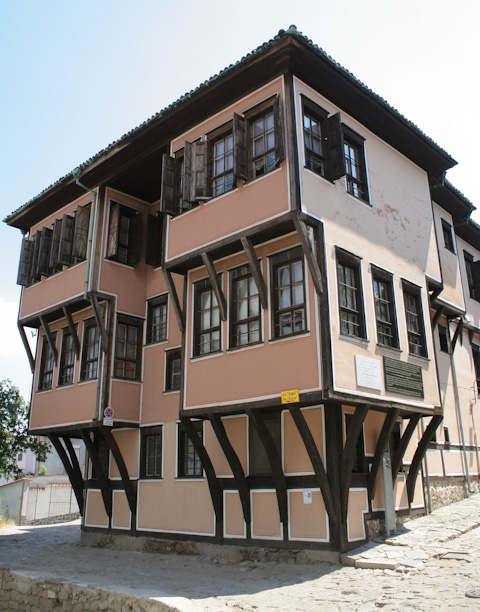
The Lamartine House
Take Tzar Ivailo back and continue right along Todor Samodumov for one more block. You’ll see this yellow house on the corner.
This is the Mavridi house, known as the Lamartine house because French national poet Alphonse de Lamartine stayed there briefly in the summer of 1883. It houses an exhibit devoted to the poet, and is a prime example of symmetric Revival architecture.
5. The City Art Gallery (E)
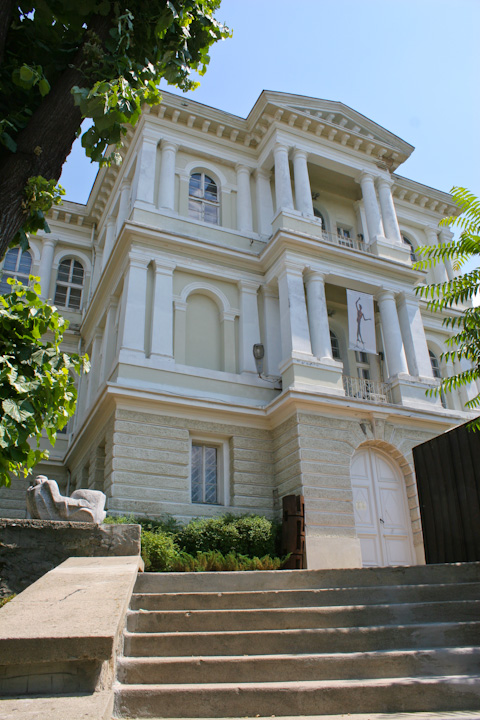
The City Art Gallery
Go back the way you came along Todor Samodumov and turn right at the first opportunity. The street name should be Stoyan Chalakov. Walking down, on your right you’ll see a set of stairs and a socialist realism mural leading up to a pale brown house.
This is the main building of the City Art Gallery. On two compact floors, it has a great collection of Bulgarian art from the late 1800’s to present day, including paintings of Vasil Levski, self-portraits of many renowned painters who worked in Bulgaria, and a scale model of the monument to Tzar Liberator in Sofia. Entrance to the gallery costs 2 Leva (1 for students), and a guided visit is 10 Leva in English.
5.5. The Gallery’s Icon Collection (F)
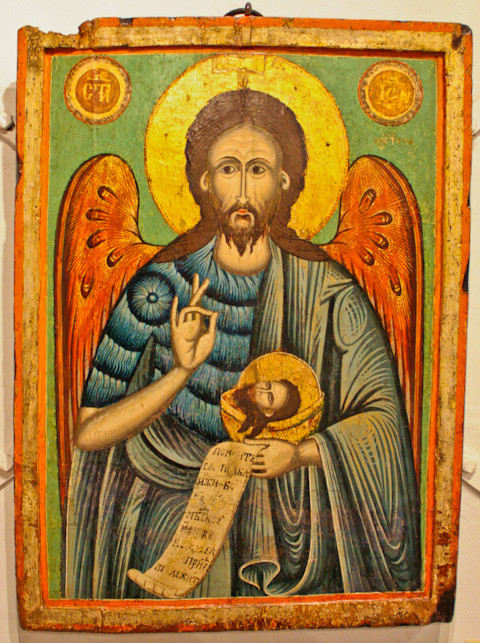
An icon from the Icon Collection
Half a block down the street, on Saborna St. 22, you can find a branch of the City Gallery devoted to iconography: the Eastern Orthodox art of painting images of saints and religious scenes. Entrance to the gallery costs 2 Leva (1 for students), and a guided visit is 10 Leva in English.
6. Sv. Konstantin & Elena Church (G)

The bell tower of St. Konstantin & Elena church
Just behind the Icon Collection, you will see a church’s bell tower jutting out above a walled-in garden. Go inside and you’ll see the facade of the beautiful Sv. Konstantin & Elena church. Entrance is free, as it is in all churches in the country, but picture-taking is not allowed inside.
7. Hisar Kapia and the Round Tower (H)

The Hisar Kapia gate
After the church, take a right and you’ll see the arch of one of the gates of the ancient fortress of Hisar Kapia, built in the 5th century AD. If you turn right again along the ancient wall that the gate hints at, you’ll reach the foundations of a round Byzantine-style tower. These are small remnants of Plovdiv’s Byzantine-era past.
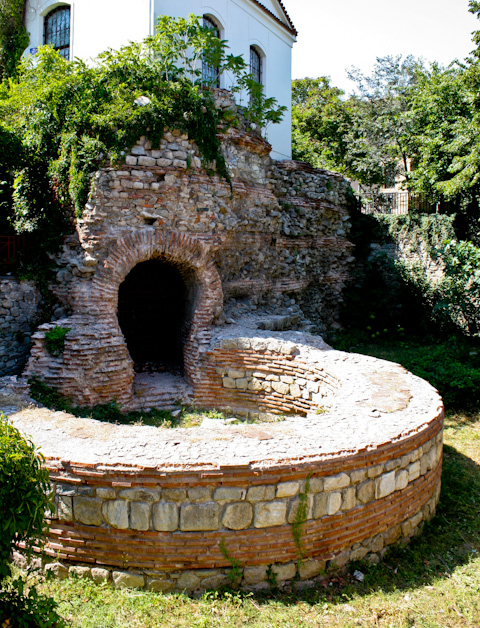
The round tower
8. Museum for National Revival (I)
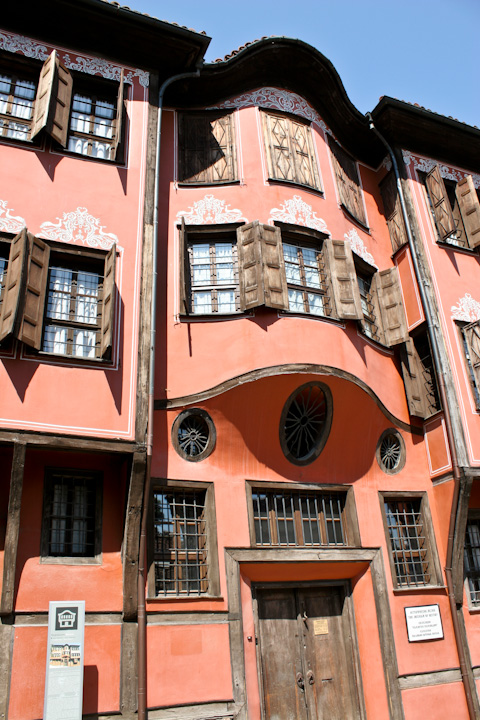
Museum for National Revival
Coming back from the Round Tower, with the Hisar Kapia gate on your left, you’ll see a big orange house ahead of you. This is the National Revival museum that houses exhibits on city life in the final years of Ottoman dominion, as well as weapons and stories from the April uprising of 1876, the Russo-Turkish war of 1877-78, and Plovdiv’s liberation. Be warned, not all the museum’s exhibits are bilingual, although there are explanatory sheets in English posted at the entrance to each exhibit room. Entrance is 2 Leva (1 Lev for students) and a guided tour of the museum costs 6 Leva. Picture-taking will set you back another 1 Lev.
9. Ethnographic Museum (J)

The Ethnographic Museum
Walk back through the Hisar Kapia gate and turn right down Dr.Chomakov street, keeping your eyes open to the right.
Walled behind a high brick fence, the most beautiful house in the Old Town also houses the city’s Ethnographic museum, i.e. the place to see what life looked like in Revival-era Plovdiv, both in the nearby villages and in the city itself. The exhibits, co-sponsored by National Geographic Bulgaria, are well arranged and decidedly worth seeing. Entrance to the museum is 5 Leva (1 Lev for students) and a guided tour in English will cost you 10 Leva.
NOTE: The Ethnographic museum is CLOSED Mondays.
10. Nebet Tepe (K)
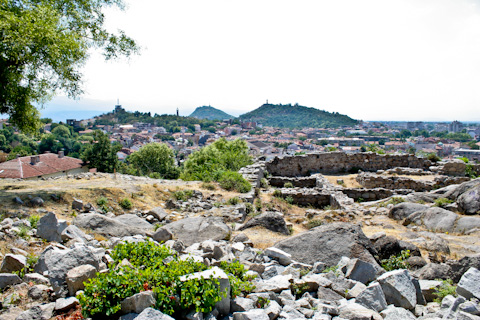
View of Plovdiv from Nebet Tepe’s fortress
Nebet Tepe (the “Nebet Hill”), one of the Old Town’s three hills, at the end of Dr. Chomakov Street, is peppered with the ruins of an ancient Thracian fortress. While not a savoury place to visit after dark, it offers incredible views of Plovdiv. Additionally, just before the path up to the fortress, on the left you will find the Bakalov house, where traditional artisans offer demonstrations of their crafts and sell their wares.
11. Balabanov and Hindliyan Houses (L)

The Hindliyan House
Go back down Dr. Chomakov street until the square before St. Konstantin & Elena. The street leading right will be called Antranik, and on the corner you’ll see the pink Balabanov House. Walk around it until you see the small gate in the wall. You can enter through there. The Balabanov house, as well as the adjacent Hindliyan house in blue (that you can reach from the Balabanov courtyard), are both perfectly restored Revival homes, housing an art gallery and a recreation of the Baroque-era sitting rooms of wealthy Bulgarian merchants in one, and a basement Turkish bath in the other. Entrance to each of the houses is 5 Leva (1 for students), and a guided tour costs 15 Leva.
12. Art Gallery Philippopolis (M)
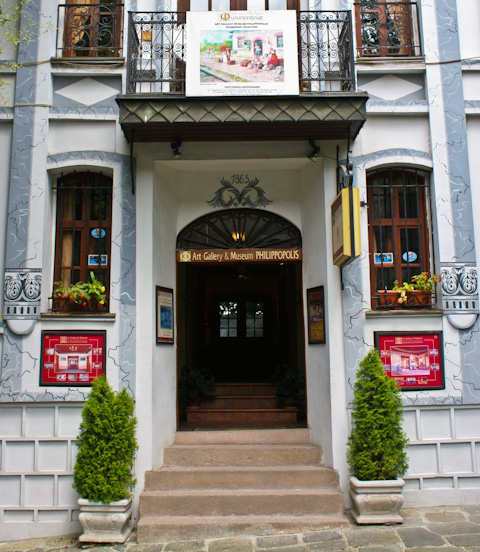
Art Gallery Philippopolis
When you’ve finished with the two houses, head back to the square and turn right, taking Saborna back towards the entrance to the Old Town. At the intersection with Vasil Kanchev and Stoyan Chalakov, Saborna veers slightly to the right. You should follow it, and at number 29, you’ll find the house of Hadji Aleko, currently private art gallery Philippopolis. It’s another beautiful Revival-era house (built around 1865).
Your tour ends at the end of Saborna, at the barrier near the stairs. Walking onwards will return you to Djumaya square, past the area known as Kapana, full of artisan shops.
Blazing Bulgaria Nominated for Very Inspiring Blogger Award!
26.07.2012 § 1 Comment
Some 50 Posts and almost 2400 pageviews since I started this blog, I feel I’ve just barely reached a small, but critical core mass of followers, casual readers and materials so I can begin to represent Bulgaria well to the world.
Which is why I was extremely pleasantly surprised when Esenga’s Voice nominated my blog for the Very Inspiring Blogger Award. Her travel and experience blog is extremely well-written, and you will find yourself re-reading many passages for the sheer beauty of her words. I want to thank her from the bottom of my heart, for honouring me in this way, but also for giving me a platform to single out those few blogs that make my life better with their inspirational writing.
Crucial Battles in Bulgaria’s Mountain Passes
26.07.2012 § Leave a comment
 Crossing the Balkan mountains, known as Стара планина (“The Old Mountain”) to the locals, usually involves winding your way up, then down, one of the range’s rugged mountain passes. The range that currently bisects Bulgaria used to be a southern bulwark against the Byzantines, and has served time and time again to slow down invaders and protect the core of the Bulgarian territory.
Crossing the Balkan mountains, known as Стара планина (“The Old Mountain”) to the locals, usually involves winding your way up, then down, one of the range’s rugged mountain passes. The range that currently bisects Bulgaria used to be a southern bulwark against the Byzantines, and has served time and time again to slow down invaders and protect the core of the Bulgarian territory.
Much like the Italian peninsula and the Alps protected Rome for centuries, much like Constantinople held on on the Golden Horn for close to 1000 years, so have the passes of the Balkan range provided a much-needed advantage in four crucial battles that shaped the course of history for the Bulgarian people.
« Read the rest of this entry »
Plovdiv’s Roman Treasures: A Walking Tour
25.07.2012 § 8 Comments

In 1968, the sports field of the Pedagogy Institute in Bulgaria’s second-largest city, sun-drenched Plovdiv, was scheduled for refurbishment. A company of the Army’s construction corps was assigned to expand the field, which involved digging deeper into one of the city’s three hills. However, the Institute never got its field, because what the diggers found underneath were the curved marble seating rows of an immaculately preserved outdoor Roman theatre.
Plovdiv, inhabited continuously since 4000 BC and Europe’s third-oldest city (after Athens and Argos), is known by many names. Settled by the Thracians as Eumolpias, it was conquered by Philip II of Macedon, the father of Alexander the Great, and given the name Philippopolis. After the decline of the Macedonian kingdom, it reverted to the Thracians, who called it Pulpudeva. When the Romans swept onto the Balkans, they called it Trimontium (“City of Three Hills”) and made it a cultural and economic hub of the Roman province of Thrace. The via militaris, one of the Roman empire’s arterial roads, passed through the city, and it thrived on the banks of the Hebros (Maritsa) river, at one time containing numerous public buildings, baths, shrines, villas, with high walls and a Roman grid system in its streets. This walking tour will take you on a trip through its main Roman-era sights.
« Read the rest of this entry »
The Comfort of Familiarity…and Big Macs (Updated)
24.07.2012 § 5 Comments
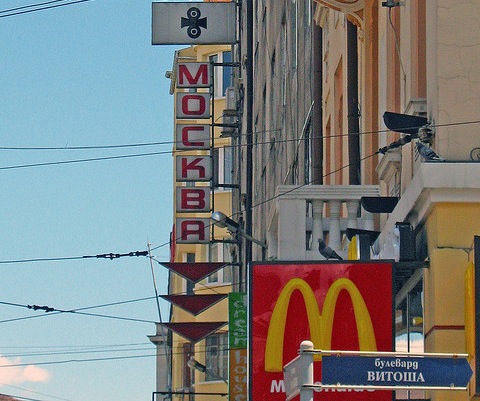
In August of 2010, I had just arrived in Sofia for a month-long stay in Bulgaria. I’d rushed out to buy кисело мляко, сирене and лютеница, to have a taste of authentic Bulgarian things, and I was excited to participate in a ritual I like to call The Walk.
The Walk essentially consists of my taking the trolley down to Sofia University and strolling through all the places in the centre of the city that I want to refresh in my memory. It is a slow, leisurely affair, notably because usually it’s undertaken in the scorching summer heat, and it serves to suffuse me with the understanding that I am, indeed, home. You will see many of these landmarks in future posts if you haven’t already, but they include the yellow cobbles, the National Theatre (where I spend a good half an hour admiring it and wondering what might have been if I’d been a superfamous actor slash director slash sex symbol person…but I digress) and a dozen other known and unknown places that really ground me, telling me “Yes, you are in Sofia”.
Entering a Bulgarian Orthodox Church
24.07.2012 § 2 Comments
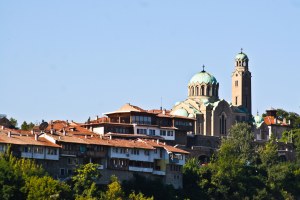
When travelling in Bulgaria, you’ll be hard-pressed to find a city or town without a church as a significant landmark. The Orthodox church was a haven for Bulgarian language and culture during the almost 500 years of Ottoman dominion and its buildings tend to be the source of much local pride. Many churches feature prominently on walking tours and tourist information sites and you’ll likely find yourself entering church after church during your stay. « Read the rest of this entry »
Public Transit in Sofia
22.07.2012 § Leave a comment
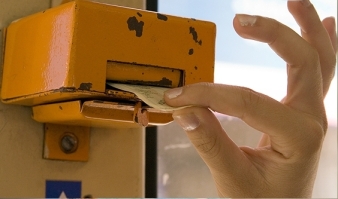
Coming to you from a secret, undisclosed location in Bulgaria’s capital, I will brief you on the essentials of the modes of public transit available to you in Sofia and their respective costs and quirks.
Tourist Information Centre Sofia
21.07.2012 § Leave a comment
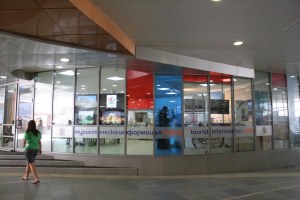
Recently opened in the Sofia University underpass (a.k.a. “Rektorata”, “SU Kliment Ohridski”, etc.), near a big transit ticket office and literally across metro station “SU Kliment Ohridski”, stands the office of the Municipality of Sofia’s Tourist Information Centre. Inside, you can find detailed maps of the city, information about tours and events and helpful, English-speaking staff.
Sofia Taxis Demystified
21.07.2012 § 3 Comments

You’re in luck. Only a couple of years ago, Sofia was crawling with gouging, faker taxis that charged 3.50 Leva per km and relied on tourists’ naiveté and inattention to fleece them. Thankfully, a couple of reliable companies have emerged, as well as legislation that caps the maximum one can charge for a certain distance.
The Burgas Bus Bombing
20.07.2012 § Leave a comment
It was my last night in Rome that I heard the news: a bus had exploded on July 18, 2012 at the airport outside the Bulgarian seaside town of Burgas in a suspected suicide attack, killing 5 Israeli tourists and the Bulgarian bus driver and injuring 32 others, some critically. It appeared to have been a targeted attack against Israeli citizens who were boarding a shuttle bus to take them to a hotel. Israeli officials have accused Iran of masterminding the attacks, although Iran has vehemently denied involvement.
Are You Sure?
16.07.2012 § Leave a comment
A mini-post about an interesting quirk of the Bulgarian language. In Bulgarian, сигурен (siguren) is an adjective that means “certain, doubtless”. However, when answering a yes/no question, “sigurno” does not mean “doubtless”, it means “perhaps”, which is far less definite. Add this to our shaking heads for “yes” and nodding for “no” and it’s no wonder Bulgaria is poorly understood 😉
The Uprising of Peter Delyan and Harald Hardrada’s Varangian Guard
11.07.2012 § 4 Comments
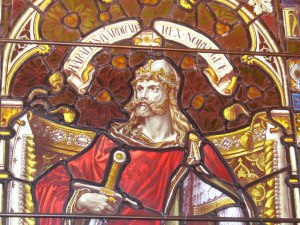 In the category “strangest pairings of national heroes”, it turns out that Harald Sigurdsson, king of Norway, later given the nickname Hardrada (“the hard ruler”) and one of the greatest heroes of Norse lore, was intimately involved in a bloody chapter of Bulgaria’s medieval history – the uprising of Peter Delyan.
In the category “strangest pairings of national heroes”, it turns out that Harald Sigurdsson, king of Norway, later given the nickname Hardrada (“the hard ruler”) and one of the greatest heroes of Norse lore, was intimately involved in a bloody chapter of Bulgaria’s medieval history – the uprising of Peter Delyan.
Off to Bulgaria!
09.07.2012 § 3 Comments
Hello, my throngs of loyal followers!
The time has come: I leave Toronto tomorrow, via Munich, Venice, Verona, Florence and Rome, for Bulgaria.
I will spend close to four weeks there, writing helpful guides and impressions on location from Sofia, Plovdiv, Veliko Tarnovo and Ruse. I will also be undertaking a 7-day hike through the Eastern Rhodopes, which will be detailed like my routes through the Balkans and Rila.
If you have requests, about anything at all (language, customs, shopping etiquette, travel guides), now is the time to send them to me as I will be able to research them at the source.
So, please comment on this post with your requests, and I will do my utmost to fulfill them.
My next post will be from sunny Sofia!
Ribbon-Cutting Works!
08.07.2012 § 1 Comment
After decades of being tossed around on the high waves of economic uncertainty and construction stagnation, the Bulgarian government is finally backing some serious infrastructural improvements to transportation. Boyko Borisov, Bulgaria’s current premier and leader of the GERB party, is the subject of thousands of political jokes and jabs, and opinions about him range from “exactly what Bulgaria needs” to “a thug with links to the Mob”. However, he has been instrumental in absorbing EU infrastructure funds and putting them to good use. Regardless of whether it’s for the good of the nation or for photo-ops at ribbon-cutting ceremonies, under his leadership Bulgaria has committed to several infrastructure projects of major importance.
